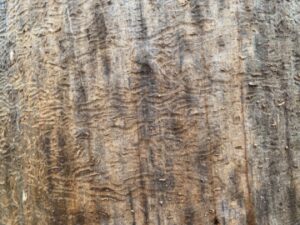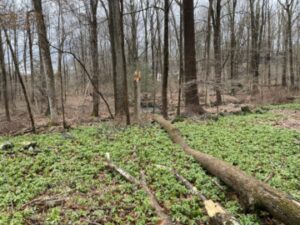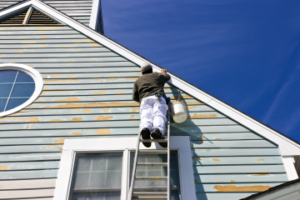
If you’re noticing an abundance of fallen limbs and tree work in the area lately, that’s because unusually high winds have been wreaking havoc and a tiny invasive insect has been quietly picking away at the ash population for the past 20 years.
At a time when so many people are talking about the hot new invasive import on the scene, the spotted lanternfly, let’s take a moment to highlight the emerald ash borer (EAB). Most likely introduced to Westchester in the late ‘90s or early 2000s, the EAB has destroyed tens of millions of ash trees since arriving in the United States.
Our first round of tree work in 2016 included felling two enormous ash trees that had been compromised and posed a risk to the house. When our arborist showed us how to spot the work of this busy little beetle, we were impressed with the unique aesthetic and intricacy of the patterns created by their elaborate tunnels under the bark of the tree and couldn’t believe that something so miniscule could be so destructive.
***
We were left with a healthy supply of high-quality firewood and told not to move any of it off the property because relocation can contribute to spread. I have heard other homeowners say their tree experts recommended hauling away the infected wood, but that seems counterintuitive if you can use the logs for fuel.

Now that I know about the dreaded emerald ash borer, it’s easy to spot the infected trees. Sadly, it seems like the majority of the species in our region is compromised. Despite clearing the trees that were first infected, it spread to every ash on our property. We have experienced ash trees losing their foliage and drying out, raining down limbs on the property (and our neighbors’ driveway … sorry about that). I even witnessed a 70-foot ash crack about 12 feet up and fall in the backyard (yes, it made a sound, a loud and scary one).
Currently, there are four infected trees left in the backyard, the most menacing of which is more than 100 feet tall and shedding all its bark to reveal a vast network of canals that create beautiful, seemingly infinite patterns on the dying tree. As it weakens over time, it will inevitably start dropping “widow-makers” until it falls. Because we value the serenity of our backyard, we’ll have to take care of it.
***
The future of the ash tree is in question, but some tree experts are optimistic that they can make a comeback. Peekskill arborist Craig Stevens told me about the potential of “survivors” (ashes that avoid succumbing to the inset).
“Arborists want to get the seeds from them so in the future they can be planted and bring on an insect-resistant tree and bring them back.” As ash, the most popular wood type used by American baseball bat makers, becomes scarcer, we may start hearing the sounds of maple and birch bats at the ballpark.
Next time you’re out and about, look for the signs of the emerald ash borer — shedding of bark, loss of leaves and the unmistakable carvings. If you see any trees in your area that look infected, contact an arborist and find out your best action plan to keep your woods healthy and your property safe.
Steve Pavlopoulos is a freelance writer and producer living in Cortlandt Manor.





